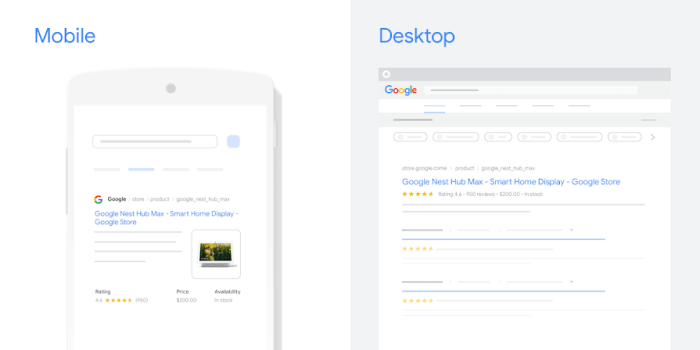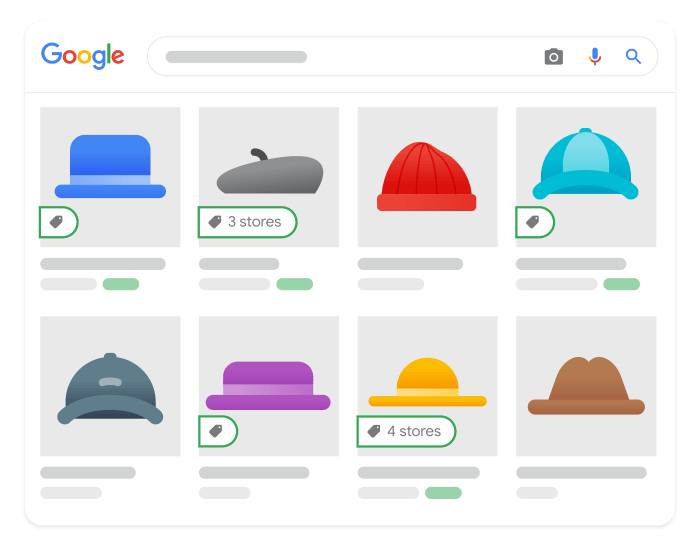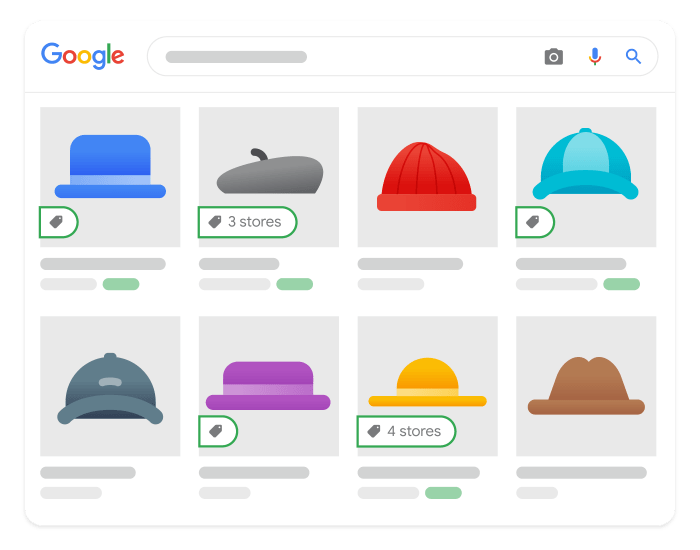Google Image Search shoppable product suggestions are revolutionizing online shopping. This feature allows users to directly purchase items they see in image search results, streamlining the buying process. From simple product links to sophisticated price comparisons, the possibilities are vast. Imagine finding the perfect dress online, and instantly clicking to buy it from the retailer’s website, all from a single image.
This blog post explores the mechanics, user experience, and impact of this innovative tool.
This feature offers a significant improvement to the image search experience, allowing users to quickly find and purchase products they see in images. It leverages image recognition technology to connect visually similar items with product listings. The various types of suggestions, from product links to related items and price comparisons, are detailed in the following sections, allowing for a deeper understanding of the potential of this innovative technology.
Introduction to Shoppable Product Suggestions in Google Image Search

Google Image Search is evolving beyond a simple visual discovery tool. Now, it’s integrating shoppable product suggestions directly into the search experience, making it easier than ever to find and buy products you see online. This feature leverages the power of image recognition and AI to connect users with relevant products, streamlining the path from discovery to purchase.This new functionality goes beyond basic image identification.
By incorporating detailed product information, pricing, and direct links to retailer websites, Google is creating a seamless shopping experience within its image search platform. This allows users to easily compare options and complete purchases without leaving the search results page.
Ways Users Interact with Shoppable Products
Users can engage with shoppable products in several intuitive ways. They can click on product links displayed alongside images to be taken directly to the product page on the retailer’s website. Alternatively, users can view related products, similar items, or even price comparisons for different versions of the same product. These interactions are designed to provide a more comprehensive view of available options and facilitate informed purchasing decisions.
Potential Benefits for Consumers and Businesses
For consumers, this feature offers a more efficient and enjoyable shopping experience. No longer do users need to manually search for products or rely on potentially inaccurate results. Direct access to product information, links, and pricing options simplifies the process. Businesses benefit from increased visibility and potential sales. Shoppable products allow them to reach a wider audience interested in their offerings, directly within Google Image Search results.
Types of Shoppable Product Suggestions
| Suggestion Type | Description | Example |
|---|---|---|
| Product Link | A direct link to the product page on a retailer’s website. | A user sees an image of a specific dress and clicks on a link to the retailer’s page to purchase it. |
| Related Products | Items similar to the image in terms of style or functionality. | An image of a pair of sneakers triggers a suggestion for related sneakers, offering users options within the same category. |
| Price Comparison | Multiple pricing options for the same or similar product from different retailers. | An image of a laptop shows different models from various retailers with corresponding prices, allowing users to compare pricing and features. |
| Similar Items | Items in the same style or design, even if they are not identical. | An image of a particular t-shirt displays similar t-shirts with variations in color or design, but retaining a comparable style. |
User Experience and Engagement with the Feature
Shoppable product suggestions in Google Image Search represent a significant shift in how users interact with visual search and online shopping. This new feature aims to streamline the purchasing process, but its effectiveness hinges heavily on user experience. Understanding how users perceive and engage with these suggestions is crucial for optimizing the feature and maximizing its impact on both users and businesses.The success of shoppable product suggestions relies on a seamless and intuitive user experience.
Users should be able to easily identify and select the desired product without being overwhelmed by irrelevant or poorly presented information. Key elements like clear visual cues, concise product descriptions, and readily available purchase options contribute to a positive user journey. A well-designed interface allows users to discover products they are interested in and efficiently complete their purchase.
Google image search is getting seriously cool with shoppable product suggestions. It’s like browsing a virtual store right from the search results. This is super useful for finding stuff you see in games like “Life is Strange 2” and helps you explore the possibilities behind the game’s visuals. This article dives deep into the game’s creators and their political commentary in the game, which makes it interesting to find those products shown in the game and discover more about the game’s themes.
It’s like the game’s visuals are now a direct gateway to the real-world products, which is pretty neat for a shoppable product search experience.
UX Considerations for Shoppable Product Suggestions
Effective shoppable product suggestions require careful consideration of the user’s visual search intent. The system should accurately interpret the user’s search query and visual context to suggest products that are relevant and desirable. The presentation should prioritize clarity and visual appeal to entice users to click through and purchase. The layout and design of the suggestions should be easy to navigate, ensuring users can quickly find the desired information and complete the purchase process.
Elements Influencing User Engagement, Google image search shoppable product suggestions
Several elements directly impact user engagement with shoppable product suggestions. The visual quality of the product images is paramount. High-resolution, clear images that accurately represent the product are more likely to attract attention and encourage clicks. Concise and informative product descriptions that highlight key features and benefits are also crucial. The ease of access to purchase options directly influences the user’s decision-making process.
Clear and readily available buttons for purchasing or adding to a cart are essential.
Ever noticed how Google Image Search can now suggest shoppable products? It’s pretty cool, right? This functionality is becoming increasingly useful, but what if the shoppable products extended beyond everyday items? Imagine finding inspiration for an innovative aircraft design like the Airbus “bird of prey” plane hybrid concept, airbus bird of prey plane hybrid concept , through a visual search.
Google Image Search could potentially connect you with 3D modeling software or materials suppliers for such a project. The possibilities for a shoppable image search are huge, especially with concepts as out-there as this!
Visual Presentation and Click-Through Rates
The visual presentation of shoppable products directly impacts click-through rates. Attractive and high-quality product images are more likely to pique user interest. Clear product categorization and concise descriptions improve the user’s ability to quickly understand and assess the product. The positioning of the purchase options within the image results should be intuitive and convenient for the user.
Proper placement and design of purchase buttons and calls to action can significantly improve conversion rates.
Table Contrasting Positive and Negative Aspects
| Positive Aspects | Negative Aspects |
|---|---|
| Ease of purchasing: Users can quickly and easily purchase products directly from the search results. This eliminates the need to navigate to separate e-commerce websites, saving time and effort. | Potential for irrelevant suggestions: The algorithm may occasionally suggest products that are not relevant to the user’s search query or visual context, leading to frustration and a negative user experience. |
| Convenience: Shoppable product suggestions offer a streamlined purchasing process, allowing users to complete purchases without leaving the search results page. | Clutter in search results: Overabundance of shoppable product suggestions can clutter the search results page, making it difficult for users to find the information they are looking for. |
| Saves time: Direct purchase options reduce the steps required to complete a purchase, saving users valuable time. | Potential for misleading information: Product descriptions and images may not always accurately reflect the actual product, potentially leading to dissatisfaction or returns. |
Impact on E-commerce and Retail

Shoppable product suggestions within Google Image Search are poised to revolutionize the way consumers discover and purchase products. This integration directly impacts the e-commerce landscape by offering a seamless transition from browsing to buying, potentially reshaping how retailers interact with customers and compete in the digital marketplace. This shift necessitates a careful understanding of both the advantages and challenges for businesses.
Impact on the E-commerce Landscape
Shoppable product suggestions significantly alter the traditional e-commerce funnel. Instead of consumers navigating through numerous search results and product pages, they can now directly access product information and purchase options within the search results. This streamlined experience is likely to increase conversion rates and boost overall sales. The ability to instantly purchase desired products directly from image search results is a game changer, providing a much more intuitive and efficient shopping experience.
This is especially beneficial for impulse purchases and quick decision-making.
Benefits for Retailers Integrating with the Feature
The benefits for retailers integrating with shoppable product suggestions are multifaceted. Firstly, it creates a direct sales channel, bypassing the need for consumers to navigate through multiple websites. Secondly, enhanced brand visibility is possible through prominent placement within search results. This visibility extends beyond organic search results, reaching a wider audience. Retailers can leverage this feature to showcase their products alongside relevant images, potentially increasing awareness and sales.
Furthermore, the ability to track user interactions with product suggestions offers valuable insights into consumer preferences and purchasing behaviors.
Google Image Search is getting seriously smart with those shoppable product suggestions. It’s amazing how easily you can find the perfect item just by browsing an image. For example, if you’re looking for a cool new dashboard app for your car, say, like a parking assistant, you might find inspiration in a picture, and then stumble upon a helpful tool like the ford parking city dash appy.
These features make online shopping so much more visual and intuitive, making it much easier to locate exactly what you’re after.
Challenges for Retailers
While the opportunities are substantial, retailers also face challenges in utilizing this feature effectively. Strategic placement of suggestions is crucial to avoid cluttering search results and ensuring relevance to user searches. Ensuring accurate product information, including pricing and availability, is paramount to building consumer trust and avoiding negative experiences. Maintaining consistent product updates to reflect inventory changes is equally vital for a seamless shopping experience.
Impact on User Shopping Behavior
Shoppable product suggestions are likely to alter user shopping behavior. Consumers will likely be more inclined to make impulse purchases due to the simplified buying process. The immediate access to products, pricing, and purchase options will encourage faster decision-making. This ease of purchase could also lead to more frequent online shopping, potentially changing consumer expectations for online retail experiences.
Advantages and Disadvantages of Shoppable Products for Retailers
| Advantages | Disadvantages |
|---|---|
| Increased sales through direct purchase options. | Potential for cannibalization of organic traffic, if not managed strategically. |
| Direct sales channel, bypassing intermediary steps. | Need for careful strategic placement of suggestions to avoid overwhelming or confusing users. |
| Enhanced brand visibility through prominent product placement in search results. | Requirement for accurate product information, including pricing, availability, and detailed descriptions, to avoid negative reviews and potential losses. |
| Data insights into user preferences and purchasing behaviors. | Potential issues with managing inventory updates and ensuring real-time accuracy of product information. |
Technical Aspects of Implementing Shoppable Products
Shoppable product suggestions in Google Image Search represent a significant leap forward in e-commerce integration. This integration requires a robust technical infrastructure capable of handling massive amounts of image data, product information, and real-time user interactions. This section dives into the technical underpinnings of this powerful feature.
Technical Infrastructure Overview
The implementation of shoppable products in image search necessitates a sophisticated technical architecture. This architecture must seamlessly integrate image recognition, product data retrieval, and real-time user interaction. Crucially, it needs to handle the scale and complexity of a global search engine. This intricate system must also remain efficient, ensuring quick response times for users.
Role of APIs and Data Integration
APIs (Application Programming Interfaces) play a pivotal role in enabling shoppable product suggestions. They act as the communication channels between various components of the system. For example, an API might connect the image recognition engine to the product database. Robust data integration is essential. This integration requires efficient data transfer mechanisms, ensuring consistency and accuracy across disparate data sources.
Product information from various retailers, manufacturers, and suppliers must be collected, organized, and made readily available.
Image Recognition and Product Matching
Accurate image recognition and product matching are fundamental to the success of shoppable product suggestions. Sophisticated algorithms are employed to identify products within images. These algorithms must account for variations in image quality, lighting conditions, and product orientation. Advanced machine learning techniques are commonly used to improve the accuracy and speed of product recognition. Matching algorithms must also consider factors like product variations, different naming conventions, and the presence of other objects in the image.
An example of this is recognizing a specific shoe model from a picture even if it has different background or lighting compared to the retailer’s product image. The development of accurate matching algorithms is an ongoing area of research and improvement.
Challenges and Solutions
Several challenges arise in implementing this feature. These challenges include the volume of data to be processed, the diversity of product types and variations, and the need for continuous improvement of the algorithms. Solutions often involve using distributed computing architectures to handle large volumes of data, implementing robust algorithms that can handle variations, and developing methods to continuously update the product database with new information.
This requires a sophisticated understanding of scaling systems and continuous integration/continuous delivery (CI/CD) practices.
Technical Components and Functions
| Component | Function |
|---|---|
| Image Recognition API | Identifies products in images. This involves using deep learning models trained on vast datasets of images and product information. |
| Product Database | Stores comprehensive product information, including details like name, description, price, images, and links to the retailer’s website. This database is crucial for enabling the matching process. |
| Matching Algorithm | Connects images to products within the database. This involves comparing features extracted from the image to features of products in the database. Sophisticated algorithms are needed to handle variations and noise in the image data. |
Future Trends and Innovations: Google Image Search Shoppable Product Suggestions
Shoppable product suggestions in Google Image Search are poised for significant evolution. The current feature is a powerful tool for e-commerce, but future developments promise even greater user engagement and a more seamless shopping experience. The integration of advanced technologies, particularly AI and image recognition, will be key to driving this evolution.The future of shoppable product suggestions lies in the ability to understand user intent and context more deeply.
This means moving beyond simple image matching to a more nuanced understanding of the user’s needs and desires. AI-powered personalization will play a pivotal role in this transition.
Enhanced AI Capabilities
Advanced AI algorithms will lead to more accurate product recognition and matching. Current systems often struggle with variations in product appearance, lighting, and backgrounds. Future systems will employ sophisticated techniques like deep learning to identify and categorize products with greater precision, even across diverse visual representations. This will lead to fewer false positives and a more relevant shopping experience.
For example, a user searching for a specific type of hiking boot might encounter variations in colors, materials, or styles, yet the AI will be able to identify the matching products with greater accuracy, reducing the user’s effort to filter through irrelevant results.
Personalized Recommendations
Future iterations of shoppable product suggestions will be increasingly personalized. Systems will learn user preferences and shopping history to offer tailored recommendations. This could include recommendations based on past purchases, browsing history, saved items, or even user interactions within the image search results. For example, a user who frequently purchases outdoor gear will receive more tailored suggestions for similar products when searching for camping equipment, increasing the likelihood of a purchase.
Integration with Other Platforms
A crucial development will be the integration of shoppable product suggestions with other user platforms. This could include connecting to user accounts on other services, such as Google accounts, allowing for a more seamless and integrated shopping experience. This feature will allow users to save products they are interested in to their accounts or directly add items to their shopping carts, simplifying the purchase process.
For instance, a user searching for a specific type of furniture might save the product to their Google account, and when they log into another Google service, the product will be available in their saved items. This integration will also allow for personalized recommendations based on user activity across multiple platforms.
Future Improvements in Shoppable Product Suggestions
| Improvement | Description |
|---|---|
| Enhanced AI capabilities | More accurate product recognition, including handling variations in appearance, lighting, and backgrounds. |
| Personalized recommendations | Suggestions tailored to user preferences, considering past purchases, browsing history, and other user interactions. |
| Integration with other platforms | Linking to user accounts, allowing for seamless saving of products, and synchronized shopping experiences across various Google services. |
Ultimate Conclusion
In conclusion, Google Image Search’s shoppable product suggestions offer a compelling blend of convenience and potential for retailers. By streamlining the purchase process, this feature can dramatically impact user shopping behavior, while also presenting both opportunities and challenges for businesses. The future of e-commerce is intertwined with the evolution of these suggestions, and ongoing advancements in image recognition and AI are sure to shape the way we shop online.




